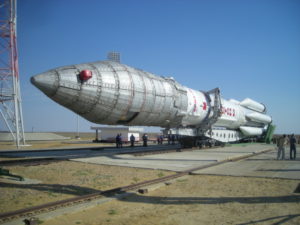Russia’s Baikonur Cosmodrome: Transboundary impacts [2022]
The recent launch from Baikonur Cosmodrome in Kazakhstan of a rocket has once again brought to the forefront the dangers posed by this space facility that is operated by Russia’s RosKosmos space program. When a rocket is launched, boosters, rocket fragments, and other waste fall away, landing with a crash back on Earth. Generally, they fall across a known stretch of Russia’s Altai Republic. On October 12, 2022, a Proton-M rocket, loaded with a telecommunications satellite, was launched from Baikonur. The satellite will provide telecommunications services across the African continent and Europe.

Altai Republic has three official fallout zones for rockets launched from Baikonur Cosmodrome. They are concentrated in Choysky, Ust’-Kan, Turochak, and Ulagan Districts, covering 23,500 sq. km, or approximately 25% of the Republic’s territory. Per terms of a 2008 agreement between the RosKosmos and Baikonur, financial compensation is to be paid for damage caused by fallout events and the debris is to be removed when it falls in an inhabited area. In reality, however, these actions are very rarely executed, despite claims to the contrary by state officials.
 Another pressing concern for Altai’s residents is heptyl, a highly toxic type of fuel used to launch the Proton rocket. Jettisoned rocket stages containing unburned heptyl can contaminate water and soil, although state officials claim that water and soil samples show no evidence of contamination.
Another pressing concern for Altai’s residents is heptyl, a highly toxic type of fuel used to launch the Proton rocket. Jettisoned rocket stages containing unburned heptyl can contaminate water and soil, although state officials claim that water and soil samples show no evidence of contamination.
The Proton rocket was introduced by the Soviet Union in 1965. As noted above, modern versions are still in use today, making it one of the most successful heavy boosters in the history of spaceflight. Proton components are manufactured in Russia and transported to the Baikonur Cosmodrome, where they are assembled to form the launch vehicle. Citing the results of long-term studies, RosKosmos has brushed aside concerns about environmental damage caused by Proton rockets.
